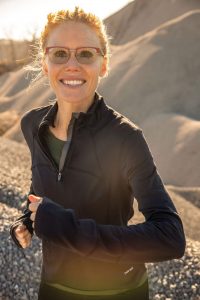Kimberly Kirklin believes in the power of art to bring healing.
With a background in Birmingham medicine that goes back generations, Kimberly Kirklin forged a new path from that taken by her well-known physician great grandfather, grandfather, grandmother and father. She found her calling not in an operating room, but within the imagination-rich arena of art and how it contributes to healing.
“I started playing the violin when I was three years old,” Kirklin says. “My music interests shifted as I explored piano, guitar and ultimately voice and theatre. I even fell in love with a high school drawing class. I found myself in the arts. I identified as an artist at an early age and it provided me with confidence I never felt in any of my academic pursuits at the time. After college when I realized I would not have a professional career onstage I found my way to arts administration. I never knew about the field growing up but I found my home at the Alys Stephens Center where I have been for over 16 years.”

Kirklin is now the director of UAB’s Institute for Arts in Medicine for the Alys Stephens Center. She served as the director of education and outreach at the ASC from 2005 to 2014, where she played a major role in the creation of ArtPlay, the ASC’s arts programs for schools, marginalized communities, and seniors in non-hospital settings.
“I knew about my own experience with the arts,” she says, “however, our work at schools and in the community opened my eyes to the impact of the arts on education and well-being. One of the most poignant moments for me occurred at a school with Sharrif Simmons, a poet and musician. He walked into a class full of kids and it wasn’t ‘school’ anymore. It was a place where children and teachers alike could be heard, respected and celebrated. He opened with one of his spoken word pieces and it was suddenly a happening. Children were invited to create their own pieces and share with the group. I have never seen so many hands shoot up. Each child would ‘perform’ his or her piece with Sharrif accompanying them on his guitar and they were honored for their contribution. This happened again and again for over 10 years. It was in moments like this when I realized how powerful the arts could be.

“Countless moments like this over a period of 10 years guided me to my interest in the arts as a tool for healing. Seeing the impact it had on school children, I wondered about the impact it may have for individuals with illness. And my research began there.”
In 2013, she led the expansion of the ASC’s reach into the healthcare community. A pilot program she co-created is now UAB’s Institute for Arts in Medicine (AIM), a partnership between the ASC and UAB Medicine. Kimberly has a BM in Musical Theatre from the University of Miami in Florida, an MA in Arts Administration from Goucher College in Towson, MD, an MA in Arts in Medicine from the University of Florida. She is currently pursuing an MA in Counseling from UAB.
Despite the family lineage, “I never had an interest in medicine,” Kirklin says. “I was a performer. How surprising then that my career would draw me right into UAB hospital and several others. I have had the joy of loving all of my work over the past 18 years at UAB. However, I have never felt more passionate about this work in arts in medicine. I also feel proud that although my work does not repair diseased organs, it contributes to the healing of the rest of the patient.”
The practice of medicine did have a major impact on Kirklin’s early life. “Although my father is no longer a surgeon he is still well connected to his field through his extensive work in research. Therefore, growing up, medicine was very much a part of my existence. My father worked long days and many nights often getting phone calls past midnight with news of an emergency or a heart that might be viable for transplantation. I also remember him getting depressed periodically if he lost a patient, particularly a child.
“My father has always been extremely focused on his work. There was a period in my early twenties when he was working on a heart transplantation textbook. While on vacation during that time, my father regularly refused to leave the car so he could keep working. I think he did take some breaks to eat, but we would just laugh and roll our eyes.”
Kirklin has found that kind of commitment in her own life as she focuses on blending her understanding of the arts with the needs of the sick. And how the arts can help in healing.
“There are so many facets to this work that it is hard to name one thing. The benefits include increased self-esteem for patients when learning a new skill, the development of a community of patients when coming together as a class to express themselves through art, or the control they can take back in a place where they may have very little control,” Kirklin says.
“However, the most beautiful thing to me is seeing one of our talented and compassionate artists in residence engage in a meaningful moment with a patient or family. In just a few moments the walls fall away, they are both fully present, and the patient can reconnect with who she really is. Not a someone with a disease, not a patient, but a whole person with a mind, body, and spirit.” •



